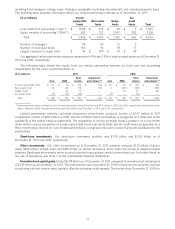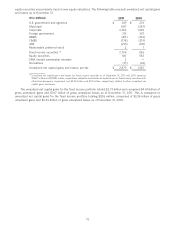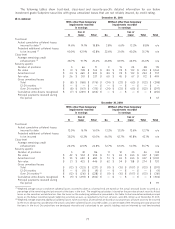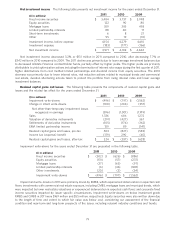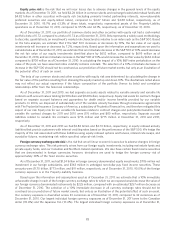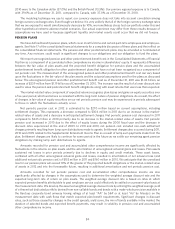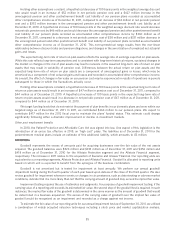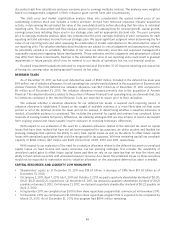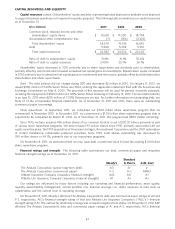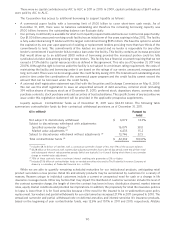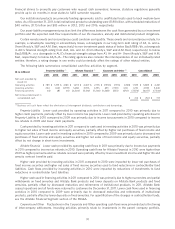Allstate 2012 Annual Report Download - page 167
Download and view the complete annual report
Please find page 167 of the 2012 Allstate annual report below. You can navigate through the pages in the report by either clicking on the pages listed below, or by using the keyword search tool below to find specific information within the annual report.policies that have been approved by their respective boards of directors. These investment policies specify the
investment limits and strategies that are appropriate given the liquidity, surplus, product profile and regulatory
requirements of the subsidiary. Executive oversight of investment activities is conducted primarily through subsidiaries’
boards of directors and investment committees. For Allstate Financial, its asset-liability management (‘‘ALM’’) policies
further define the overall framework for managing market and investment risks. ALM focuses on strategies to enhance
yields, mitigate market risks and optimize capital to improve profitability and returns for Allstate Financial. Allstate
Financial ALM activities follow asset-liability policies that have been approved by their respective boards of directors.
These ALM policies specify limits, ranges and/or targets for investments that best meet Allstate Financial’s business
objectives in light of its product liabilities.
We manage our exposure to market risk through the use of asset allocation, duration, simulation, and as
appropriate, through the use of stress tests. We have asset allocation limits that place restrictions on the total funds that
may be invested within an asset class. Comprehensive day-to-day management of market risk within defined tolerance
ranges occurs as portfolio managers buy and sell within their respective markets based upon the acceptable boundaries
established by investment policies. For Allstate Financial, this day-to-day management is integrated with and informed
by the activities of the ALM organization. This integration is intended to result in a prudent, methodical and effective
adjudication of market risk and return, conditioned by the unique demands and dynamics of Allstate Financial’s product
liabilities and supported by the continuous application of advanced risk technology and analytics.
Although we apply a similar overall philosophy to market risk, the underlying business frameworks and the
accounting and regulatory environments differ considerably between the Property-Liability and Allstate Financial
businesses affecting investment decisions and risk parameters.
Interest rate risk is the risk that we will incur a loss due to adverse changes in interest rates relative to the interest
rate characteristics of our interest bearing assets and liabilities. This risk arises from many of our primary activities, as
we invest substantial funds in interest-sensitive assets and issue interest-sensitive liabilities. Interest rate risk includes
risks related to changes in U.S. Treasury yields and other key risk-free reference yields.
We manage the interest rate risk in our assets relative to the interest rate risk in our liabilities. One of the measures
used to quantify this exposure is duration. Duration measures the price sensitivity of the assets and liabilities to changes
in interest rates. For example, if interest rates increase 100 basis points, the fair value of an asset with a duration of 5 is
expected to decrease in value by 5%. To calculate the duration gap between assets and liabilities, we project asset and
liability cash flows and calculate their net present value using a risk-free market interest rate adjusted for credit quality,
sector attributes, liquidity and other specific risks. Duration is calculated by revaluing these cash flows at alternative
interest rates and determining the percentage change in aggregate fair value. The cash flows used in this calculation
include the expected maturity and repricing characteristics of our derivative financial instruments, all other financial
instruments, and certain other items including unearned premiums, property-liability insurance claims and claims
expense reserves, annuity liabilities and other interest-sensitive liabilities. The projections include assumptions (based
upon historical market experience and our experience) that reflect the effect of changing interest rates on the
prepayment, lapse, leverage and/or option features of instruments, where applicable. The preceding assumptions relate
primarily to mortgage-backed securities, municipal housing bonds, callable municipal and corporate obligations, and
fixed rate single and flexible premium deferred annuities. Additionally, the calculations include assumptions regarding
the renewal of property-liability policies.
As of December 31, 2011, the difference between our asset and liability duration was a (0.62) gap, compared to a
(0.65) gap as of December 31, 2010. A negative duration gap indicates that the fair value of our liabilities is more
sensitive to interest rate movements than the fair value of our assets. The Property-Liability segment generally
maintains a positive duration gap between its assets and liabilities due to the relatively short duration of auto and
homeowners claims, which are its primary liabilities. The Allstate Financial segment may have a positive or negative
duration gap, as the duration of its assets and liabilities vary with its product mix and investing activity. As of
December 31, 2011, Property-Liability had a positive duration gap while Allstate Financial had a negative duration gap.
In the management of investments supporting the Property-Liability business, we adhere to an objective of
emphasizing safety of principal and consistency of income within a total return framework. This approach is designed to
ensure our financial strength and stability for paying claims, while maximizing economic value and surplus growth.
For the Allstate Financial business, we seek to invest premiums, contract charges and deposits to generate future
cash flows that will fund future claims, benefits and expenses, and that will earn stable spreads across a wide variety of
interest rate and economic scenarios. To achieve this objective and limit interest rate risk for Allstate Financial, we
adhere to a philosophy of managing the duration of assets and related liabilities within predetermined tolerance levels.
81


